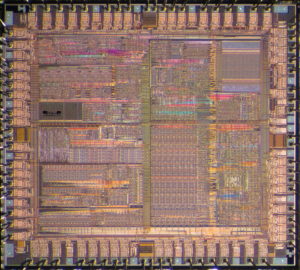 Copy DSP CPLD Embeded Firmware
Copy DSP CPLD Embeded Firmware
Copy DSP CPLD Embeded Firmware from CPLD memory needs to reverse engineering CPLD and get the CPLD scheme in order to locate the security fuse bit of CPLD, and then use Microcontroller cracking technique to remove the protection;
The most important tool for reverse engineering silicon chips down to 0.18 µm feature size is an optical microscope with a CCD camera to produce mosaics of high-resolution photographs of the chip surface. Not every microscope would do. As light cannot pass through the chip, the microscope should have reflected light illumination. The image should be sharp and without geometric distortion and colour aberration, otherwise it will not be possible to stick all the images together.
The most important parameters of the microscope are resolution and magnification. The resolution of a microscope mainly depends upon its objective lenses and is defined as the smallest distance between two points on a specimen that can still be distinguished as two separate entities. Resolution is a somewhat subjective value in microscopy because at high magnification an image may appear non-sharp but still be resolved to the maximum ability of the objective.
